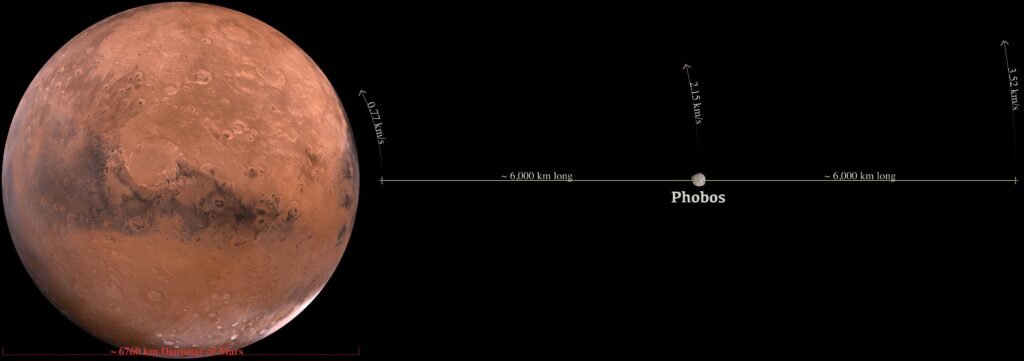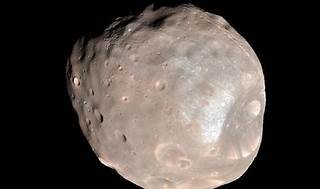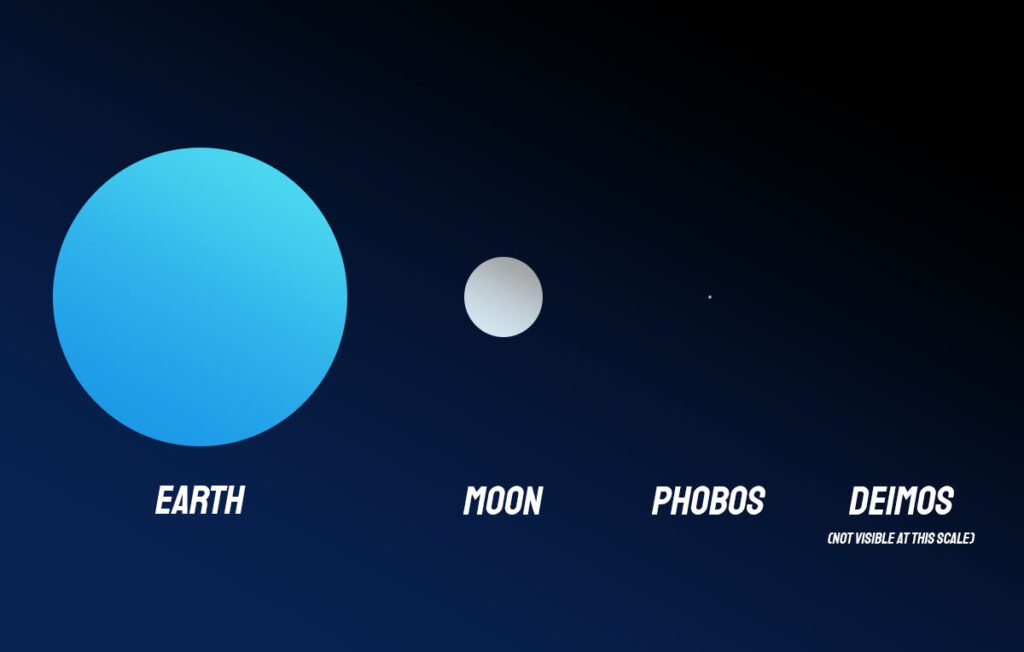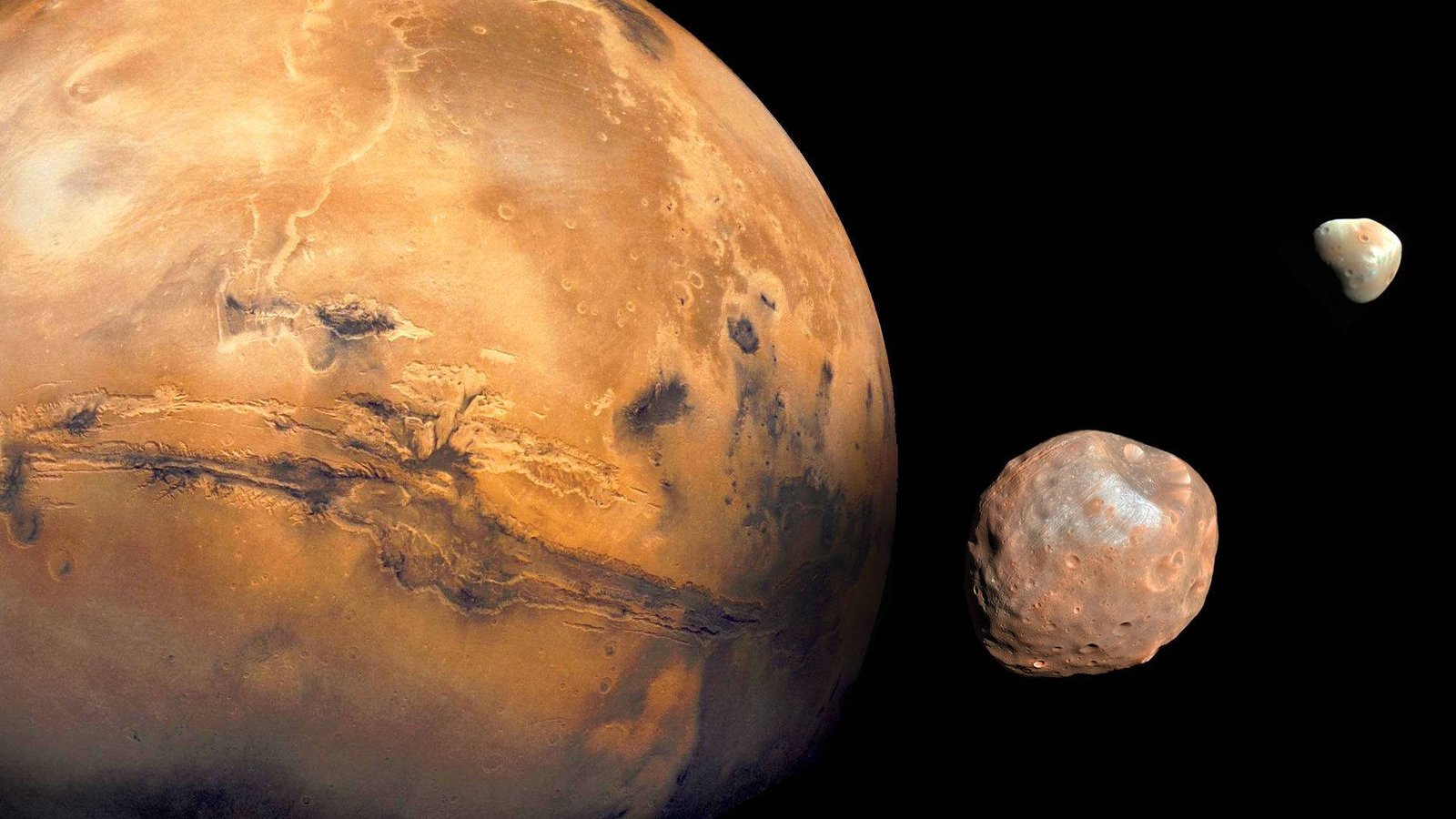How Many Moons Does Mars Have? Discovering the Red Planet’s Natural Satellites
How many Moon does Mars have? Well, Mars has 2 satellites one is Phobos and the another one is Deimos. Let’s explore more about their characteristics Mars, often referred to as the “Red Planet,” captivates scientists and astronomers with its stark landscapes and potential for human habitation. But one of its less discussed yet equally fascinating aspects are its natural satellites. In this article, we delve deep into answering the question: How many moons does Mars have? We’ll explore their origins, characteristics, and the role they play in the broader context of planetary science and exploration.

Mars, our red neighboring planet, has always captivated human imagination and scientific curiosity. While its surface and potential for harboring past or present life forms have been the focus of numerous missions, the Martian moons, Phobos and Deimos, hold their own mysterious allure. Mars is orbited by these two small moons, each with its unique characteristics and mysteries. This detailed exploration sheds light on Phobos and Deimos, enhancing our understanding of the Martian system and the broader mechanism of celestial bodies.
How Many Moons Does Mars Have?
The Moons of Mars: An Overview
Mars is orbited by two small moons, Phobos and Deimos. Unlike Earth’s moon, these are not spherical but are rather irregularly shaped, bearing more resemblance to asteroids. This section will cover the basic facts about these celestial bodies, providing a snapshot of their dimensions, orbits, and composition. Phobos, the larger and closer of Mars’ two moons, orbits the planet at a mere 6000 kilometers (about 3700 miles) above the Martian surface. This proximity makes Phobos the only moon in the solar system that orbits its planet faster than the planet rotates. A day on Phobos is incredibly short, lasting just over 7 hours.
Unveiling Phobos: The Larger Moon of Mars

Origins and Discovery
Phobos, the larger of the two moons, was discovered by Asaph Hall in 1877. We’ll look at the history of its discovery and the tools and techniques used to identify this moon.
Physical Characteristics
Phobos is marked by its irregular shape and heavily cratered surface. Here, we discuss its size, shape, surface features, and internal composition.
Orbital Dynamics
The orbit of Phobos is closer to Mars than any other moon in the solar system is to its primary planet. This segment will explore how Phobos orbits Mars and how its proximity affects both the moon and the planet.
Phobos’s Impact on Mars
Interactions between Phobos and the Martian atmosphere, as well as its potential future impact on the planet, are crucial areas of study. This part examines the gravitational effects and the long-term fate of Phobos.
Origin and Composition
The origin of Phobos is still a subject of debate among scientists. The prevailing theory suggests that both Martian moons are captured asteroids, pulled into orbit by Mars’ gravitational force. Phobos’ composition, inferred from spectroscopic analysis, appears to be similar to Type I or II carbonaceous chondrites, with a porous, cratered surface that includes the massive Stickney crater, measuring 9 kilometers in diameter.
How many Moon does Mars have? Future Fate
Phobos’ orbit is decaying, bringing it closer to Mars by about 1.8 meters every century. Calculations suggest that within 30 to 50 million years, Phobos may either collide with Mars or be torn apart by gravitational forces, creating a ring around the planet.
Exploring Deimos: The Smaller Moon of Mars
Discovery and Naming
Similar to Phobos, Deimos was discovered by Asaph Hall. This section will cover the story of its discovery and the origin of its name. Deimos, the smaller and farther moon, presents a stark contrast to Phobos. Its orbit lies 23,460 kilometers (about 14,577 miles) from Mars, leading to a much longer orbital period of about 30.3 hours. Deimos’ appearance is less irregular than Phobos, and its surface is smoother, with less pronounced craters.
Physical Attributes
Deimos is smaller and less irregular than Phobos. Here, we detail its dimensions, surface features, and what it tells us about the moon’s past.

Orbital Characteristics
The orbit of Deimos is further from Mars and less understood. This segment discusses its orbital path, period, and the implications for its stability and visibility from Mars.
Scientific Importance of Deimos
Despite its size, Deimos has significant scientific value. This part highlights the research conducted on Deimos and its importance in understanding Martian natural satellites.
Composition and Features
Like Phobos, Deimos is believed to be an asteroid that was captured by Mars’ gravitational field. Its composition closely resembles that of a D-type asteroid, with a smoother, dust-covered surface due to the lesser influence of Mars’ gravity. The most prominent feature on Deimos is the crater Voltaire, which is about 3 kilometers in diameter.
Comparative Analysis: Phobos and Deimos
Differences in Physical and Orbital Characteristics
A side-by-side comparison of the physical and orbital characteristics of Mars’ moons provides insight into their origins and their current state.
Theories About Their Origin
Are Phobos and Deimos captured asteroids or fragments from Mars itself? This section explores the various theories proposed by scientists.

| Feature | Phobos | Deimos |
|---|---|---|
| Mean Radius | 11.1 km | 6.2 km |
| Surface Area | Approx. 1,548 km² | Approx. 495 km² |
| Volume | Approx. 5,783 km³ | Approx. 999 km³ |
| Mass | 1.08 × 10¹⁶ kg | 1.48 × 10¹⁵ kg |
| Density | 1.88 g/cm³ | 1.47 g/cm³ |
| Orbital Period | 0.319 days | 1.262 days |
| Semi-major Axis | 9,376 km | 23,460 km |
| Eccentricity | 0.0151 | 0.0002 |
| Albedo | 0.071 | 0.068 |
| Surface Gravity | 0.0057 m/s² | 0.003 m/s² |
| Escape Velocity | 11.39 m/s | 5.556 m/s |
Theories About Their Origin:
- Captured Asteroids: Phobos and Deimos might be captured asteroids from the main asteroid belt.
- Mars Fragments: They could be fragments from Mars itself, resulting from an impact event.
- Binary Asteroids: They may have been a binary asteroid pair that Mars captured.
- Large Impact Theory: A large collision early in Mars’ history might have ejected parts of the planet into space, forming the moons.
These theories are based on the moons’ stable orbits and their composition, which is similar to carbonaceous chondrites. The exact origin of Phobos and Deimos is still being studied by scientists.
The Role of Mars’ Moons in Space Exploration
Mars’ Moons as Launch Pads
The potential of using Phobos and Deimos as staging areas for missions to Mars and beyond is an exciting possibility. This part examines how these moons could play a role in future human space exploration.
Scientific Missions to Phobos and Deimos
Several proposed missions aim to explore these moons more closely. Here, we discuss past, current, and future missions to Phobos and Deimos, highlighting their objectives and findings.
Mars and Its Natural Satellites: A Broader Perspective
Impact on Martian Climate and Geology
The existence of moons around Mars has implications for its climate and geological evolution. This section delves into how Phobos and Deimos influence Mars.
Comparisons with Moons of Other Planets
Comparing Mars’ moons with those of other planets can provide broader insights into planetary science. This comparative analysis looks at how the moons of different planets vary and what these differences signify about their respective planets.
FAQs: Everything You Wanted to Know About Mars’ Moons
How do Phobos and Deimos affect Mars’ gravity?
Phobos and Deimos, Mars’ two moons, exert a minimal gravitational influence on the planet due to their small sizes and distances. Phobos, larger at 22.2 kilometers in diameter and orbiting 6,000 kilometers from Mars, and Deimos, smaller at 12.4 kilometers and orbiting 20,000 kilometers away, have relatively weak gravitational forces due to their low masses. Despite this, they are tidally locked to Mars, always showing the same face as they orbit. Their gravitational effects, though minor compared to larger moons in the solar system, contribute to our understanding of Mars’ formation and evolution, studied through various space missions.
Why are Mars’ moons not spherical like our moon?
Mars’ moons, Phobos and Deimos, are not spherical like our Moon primarily because of their smaller sizes and formation mechanisms. Phobos, the larger of the two, is heavily elongated with dimensions closer to 27 × 22 × 18 kilometers, while Deimos is even smaller and irregularly shaped. Unlike Earth’s Moon, which formed through a massive collision early in the solar system’s history and subsequently evolved into a spherical shape due to its own gravity, Phobos and Deimos likely originated as captured asteroids or debris from impacts with Mars.
Their irregular shapes reflect their origins and the processes that shaped them. Despite their asymmetrical forms, these moons play crucial roles in planetary science, offering insights into Mars’ past and its gravitational interactions. Studying their composition and orbits provides valuable data for understanding the broader dynamics of planetary satellites and their evolutionary paths within our solar system.
What missions have been sent to study Mars’ moons?
Several missions have been launched to study Mars’ moons, Phobos and Deimos. One notable mission was the Soviet Union’s Phobos program, which sent two spacecraft, Phobos 1 and Phobos 2, in 1988. Phobos 1 encountered technical issues and lost contact before reaching Mars, while Phobos 2 successfully orbited the planet and studied Phobos, although it too lost contact shortly before its intended landing.
More recently, NASA’s Mars Reconnaissance Orbiter (MRO) has provided valuable data on both moons from orbit around Mars. The European Space Agency (ESA) planned a mission called “ExoMars Trace Gas Orbiter” to also study the Martian moons, focusing on their composition and origins. These missions aim to unravel the mysteries surrounding Phobos and Deimos, shedding light on their formation, evolution, and their intriguing relationship with Mars itself.
Could humans ever inhabit Phobos or Deimos?
Human habitation of Phobos or Deimos presents significant challenges due to their small sizes and low gravity. Phobos, for instance, has extremely weak surface gravity, about 1/1000th that of Earth, which could lead to health issues for long-term residents. Both moons lack a substantial atmosphere and are exposed to high levels of radiation, requiring robust shielding and life support systems. Despite these obstacles, their proximity to Mars makes them potential candidates for scientific research stations or staging areas for missions deeper into the solar system. Future technological advancements and missions may provide more insights into the feasibility of human presence on these moons, but it would necessitate innovative solutions to mitigate the physiological and environmental challenges posed by their unique conditions.
How do Phobos and Deimos compare to Earth’s moon?
Phobos and Deimos, the moons of Mars, differ significantly from Earth’s moon in several key aspects. Both Phobos and Deimos are much smaller and irregularly shaped compared to the Moon, which is nearly spherical and significantly larger in diameter. Phobos measures about 22.2 kilometers in diameter, while Deimos is even smaller at around 12.4 kilometers, whereas Earth’s moon has a diameter of about 3,474 kilometers.
Another notable difference is their origins: Phobos and Deimos are believed to be captured asteroids or debris from impacts with Mars, resulting in their irregular shapes and relatively low densities. In contrast, the Moon is thought to have formed from a giant impact with Earth early in the solar system’s history. Despite these differences, all three moons play important roles in planetary science, offering insights into the processes of moon formation and the evolution of their respective planets.
What future missions are planned for Mars’ moons?
Several future missions are planned to explore Mars’ moons, Phobos and Deimos. NASA and the European Space Agency (ESA) are considering joint missions to study Phobos in detail, potentially involving sample return missions to bring back Martian moon material to Earth for analysis. Additionally, Japan’s space agency, JAXA, has proposed a mission called MMX (Martian Moons eXploration) to Phobos, aiming to collect samples and study the moon’s composition and geological history.
These missions aim to unravel the mysteries surrounding the origin and evolution of Mars’ moons, shedding light on their composition, structure, and relationship to Mars itself. By studying Phobos and Deimos up close, scientists hope to gain valuable insights into the history of the Martian system and the broader processes of planetary moon formation in our solar system.
Understanding how many moons Mars has not only satisfies curiosity but also enriches our knowledge of the solar system’s dynamics. Phobos and Deimos, with their unique characteristics and histories, continue to be subjects of significant scientific interest. As we plan future missions, these tiny moons could provide the answers to many questions about the cosmos. Phobos and Deimos, with their unique characteristics and the mysteries they hold, are more than mere celestial bodies orbiting Mars. They are keys to understanding not only the Martian environment but also broader questions about the solar system’s formation and evolution. Future missions to these moons could unlock many secrets, from the origins of the solar system to the potential for life on Mars. For space exploration enthusiasts and scientists alike, Phobos and Deimos stand as beacons in our quest to comprehend the cosmos.

